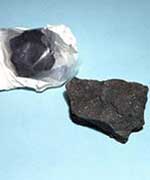A new theory of how planets form finds havens of stability amid violent turbulence in the swirling gas that surrounds a young star. These protected areas are where planets can begin to form without being destroyed. The theory will be published in the February issue of the journal Icarus.
“This is another way to get a planet started. It marries the two main theories of planet formation,” said Richard Durisen, professor of astronomy and chair of that department at Indiana University Bloomington. Durisen is a leader in the use of computers to model planet formation.
Watching his simulations run on a computer monitor, it’s easy to imagine looking down from a vantage point in interstellar space and watching the process actually happen.
A green disk of gas swirls around a central star. Eventually, spiral arms of yellow begin to appear within the disk, indicating regions where the gas is becoming denser. Then a few blobs of red appear, at first just hints but then gradually more stable. These red regions are even denser, showing where masses of gas are accumulating that might later become planets.
The turbulent gases and swirling disks are mathematical constructions using hydrodynamics and computer graphics. The computer monitor displays the results of the scientists’ calculations as colorful animations.
“These are the disks of gas and dust that astronomers see around most young stars, from which planets form,” Durisen explained. “They’re like a giant whirlpool swirling around the star in orbit. Our own solar system formed out of such a disk.”
Scientists now know of more than 130 planets around other stars, and almost all of them are at least as massive as Jupiter. “Gas giant planets are more common than we could have guessed even 10 years ago,” he said. “Nature is pretty good at making these planets.”
The key to understanding how planets are made is a phenomenon called gravitational instabilities, according to Durisen. Scientists have long thought that if gas disks around stars are massive enough and cold enough, these instabilities happen, allowing the disk’s gravity to overwhelm gas pressure and cause parts of the disk to pull together and form dense clumps, which could become planets.
However, a gravitationally unstable disk is a violent environment. Interactions with other disk material and other clumps can throw a potential planet into the central star or tear it apart completely. If planets are to form in an unstable disk, they need a more protected environment, and Durisen thinks he has found one.
As his simulations run, rings of gas form in the disk at an edge of an unstable region and grow more dense. If solid particles accumulating in a ring quickly migrate to the middle of the ring, the core of a planet could form much faster.
The time factor is important. A major challenge that Durisen and other theorists face is a recent discovery by astronomers that giant gas planets such as Jupiter form fairly quickly by astronomical standards. They have to — otherwise the gas they need will be gone.
“Astronomers now know that massive disks of gas around young stars tend to go away over a period of a few million years,” Durisen said. “So that’s the chance to make gas-rich planets. Jupiter and Saturn and the planets that are common around other stars are all gas giants, and those planets have to be made during this few-million-year window when there is still a substantial amount of gas disk around.”
This need for speed causes problems for any theory with a leisurely approach to forming planets, such as the core accretion theory that was the standard model until recently.
“In the core accretion theory, the formation of gas giant planets gets started by a process similar to the way planets such as Earth accumulate,” Durisen explained. “Solid objects hit each other and stick together and grow in size. If a solid object grows to be about 10 times the mass of Earth, and there’s also gas around, it becomes massive enough to grab onto a lot of the gas by gravity. Once that happens, you get rapid growth of a gas giant planet.”
The trouble is, it takes a long time to form a solid core that way — anywhere from about 10 million to 100 million years. The theory may work for Jupiter and Saturn, but not for dozens of planets around other stars. Many of these other planets have several times the mass of Jupiter, and it’s very hard to make such enormous planets by core accretion.
The theory that gravitational instabilities by themselves can form gas giant planets was first proposed more than 50 years ago. It’s recently been revived because of problems with the core accretion theory. The idea that vast masses of gas suddenly collapse by gravity to form a dense object, perhaps in just a few orbits, certainly fits the available time frame, but it has some problems of its own.
According to the gravitational instability theory, spiral arms form in a gas disk and then break up into clumps that are in different orbits. These clumps survive and grow larger until planets form around them. Durisen sees these clumps in his simulations — but they don’t last long.
“The clumps fly around and shear out and re-form and are destroyed over and over again,” he said. “If the gravitational instabilities are strong enough, a spiral arm will break into clumps. The question is, what happens to them?”
Co-authors of the paper are IU doctoral student Kai Cai and two of Durisen’s former students: Annie C. Mejia, postdoctoral fellow in the Department of Astronomy, University of Washington; and Megan K. Pickett, associate professor of physics and astronomy, Purdue University Calumet.
Original Source: Indiana University News Release

